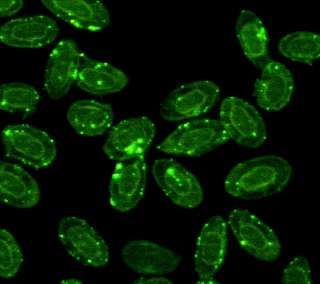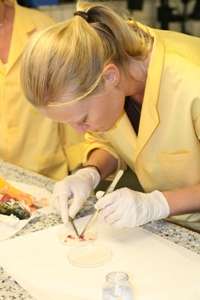ISA virus infects salmon from within

New findings on the interaction between an influenza-related virus and the host provide a significant contribution to understanding disease mechanisms behind the serious fish disease Infectious salmon anemia (ISA).
The severity of ISA is emphasized by the fact that it is the only disease of farmed Atlantic salmon listed by the OIE (World Organisation for Animal Health). Typically, an ISA outbreak starts in one cage and spreads over weeks and months to neighboring cages. If nothing is done to limit the spread of infection large numbers of fish can be lost.
But, how exactly does salmon get ISA? And why do rainbowtrout, a close relative of Atlantic salmon, not get the disease, even though they may carry the virus? Many questions are unanswered. Researchers at the Norwegian Veterinary Institute and the Norwegian School of Veterinary Science have made important new discoveries, providing essential contribution towards understanding the interaction between Atlantic salmon and the virus, and how this interaction is leading to ISA.
The findings are so interesting that they got published in the prestigious Journal of Virology, and may prove to be interesting in regards of influenza research in general.
Virus lock and key
"Our approach in this work has been that if we understand more of what is happening in the fish, we might be able to identify factors in the host and in the virus that are important for the development of the disease," says senior researcher Knut Falk. He is leading the research project that is part of the doctoral work of PhD-student Maria Aamelfot.
"We examined ISA-diseased fish and studied which tissues and cells that become infected with the virus. Then, by using a novel method we determined to which tissues and cells the virus has a potential to attach to on healthy fish. The idea was to see what happened in the diseased fish, and then compare this with what happens at the molecular level when the fish becomes infected," says Aamelfot.
"For a virus to be able to infect a cell, it first needs to recognize the cell. We found that the ISA virus recognizes very specific cells in Atlantic salmon, endothelial cells. These are the cells that line the luminal surface of blood vessels and the rest of the circulatory system, including the heart," adds Falk.
"A prerequisite for a virus to be able to infect a cell is that the cell has specific structures (receptors) on the surface. Various viruses often use different receptors and the virus binding to these is very specific receptors- like lock and key. The researchers have managed to show that the ISA virus receptor covers the inside the blood vessels of Atlantic salmon. It is the first time anyone has visualized this receptor in tissue sections, and shown the cell specific expression," says Aamelfot.

Two approaches compared
The researchers have devised a new method to detect the receptor or "lock" on the cells, using the virus as a probe or "key". The method is based on making a virus preparation which contains the "keys", and then to see where in healthy fish the key finds its lock.
They found that endothelial cells and red blood cells almost exclusively had the specific "lock" for this virus.
By comparing this expression pattern with the cells found infected in diseased fish, they found a good resemblance. The cells that were found to be infected were the same type of cells that expressed the virus receptor. At the same time, the researchers also noted other cell types which were not infected during the process. "These results give new information and insights and is an important piece of the puzzle to understand the disease," says Aamelfot.
Virus on red blood cells surface
Aamelfot explains that the endothelial cells that line blood vessels have a specialized surface. "We showed that new virus particles are released from this surface, which then goes straight into the bloodstream. This is different from a number of other viral infections where the virus penetrates deeper into the tissue around the blood vessels."
"When the virus is in the blood vessels, they will attach to the red blood cells. The red blood cells have virus receptors on the surface however after attachment the virus remains on the surface of the cells, and the virus is unable to multiply within them. This passive binding to the surface is an important additional findings," she points out. "It indicated that the red blood cells can spread the virus in the blood stream."
Causes cardiovascular problems
Virus coated red blood cells that circulate in the blood vessels can cause problems for the blood circulation. "In normal blood vessels, the surface is smooth and the blood flows freely, without any obstacles. We believe that virus on the surface of red blood cells prevent them from floating freely and that this contributes to the characteristic circulatory disturbances commonly seen in salmon with ISA," adds Falk. "The salmon with ISA get anemic, and their blood flow is altered. Moreover, the results indicate that the cell membrane of the red blood cells is damaged due to virus binding. We believe this is very important for the development of the disease and this is something we want to work on in the future."
With one foot in an unknown and exciting terrain
Aamelfot explains that the endothelial cells have several important functions, both with regards to blood circulation, but also related to the defense against infections. "The endothelial cell surface is covered by a "cloud" of sugar chains that both protects the cells and participates in communication between cells. In our research, we showed for the first time that the tissue distribution of a particular sugar molecule is found at the outermost end of this sugar cloud, a sialic acid-species important for good blood flow and protection," says Aamelfot. She compares this sugar coat with the paint on a car. Just like your car can rust if the paintwork gets scratched, the defense mechanisms may be impaired if the sugar team gets "hurt".
Small steps, big impact
Falk says that the results are of great importance for research on ISA. "When we have turned more pieces in this puzzle, we will understand more of what happens with this disease. Disease caused by other influenza viruses is important in many species including human, so this is an important research area." Falk is sure that the findings related to ISA will increase the understanding of the disease progression in other types of influenza infection, especially those that attack the endothelium.
"Expression of the Infectious Salmon Anemia Virus Receptor of Atlantic Salmon Endothelial Cells Correlate with the Cell Tropism of The Virus" was published in Journal of Virology, Volume 86 No. 19 page 10571-10578, and was written by Maria Aamelfot, Ole Bendik Dale, Simon Chioma Weli and Knut Falk from the Norwegian Veterinary Institute and Erling Olaf Koppang from the Norwegian School of Veterinary Science. The PhD-project is funded by the Canadian Research Fund Atlantic Innovation Fund Canada Inc. and Novartis Aqua Health, Canada.
More information: jvi.asm.org/content/86/19/10571.abstract
Journal information: Journal of Virology
Provided by Norwegian School of Veterinary Science















